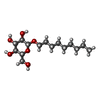+ Open data
Open data
- Basic information
Basic information
| Entry | Database: PDB / ID: 2qks | ||||||
|---|---|---|---|---|---|---|---|
| Title | Crystal structure of a Kir3.1-prokaryotic Kir channel chimera | ||||||
 Components Components | Kir3.1-prokaryotic Kir channel chimera | ||||||
 Keywords Keywords | METAL TRANSPORT / CHIMERA / G-PROTEIN GATED INWARD RECTIFIER / POTASSIUM CHANNEL / SELECTIVITY FILTER | ||||||
| Function / homology |  Function and homology information Function and homology informationI(KACh) inward rectifier potassium channel complex / G-protein activated inward rectifier potassium channel activity / Activation of G protein gated Potassium channels / Inhibition of voltage gated Ca2+ channels via Gbeta/gamma subunits / inward rectifier potassium channel complex / voltage-gated monoatomic ion channel activity involved in regulation of presynaptic membrane potential / regulation of monoatomic ion transmembrane transport / inward rectifier potassium channel activity / parallel fiber to Purkinje cell synapse / potassium ion import across plasma membrane ...I(KACh) inward rectifier potassium channel complex / G-protein activated inward rectifier potassium channel activity / Activation of G protein gated Potassium channels / Inhibition of voltage gated Ca2+ channels via Gbeta/gamma subunits / inward rectifier potassium channel complex / voltage-gated monoatomic ion channel activity involved in regulation of presynaptic membrane potential / regulation of monoatomic ion transmembrane transport / inward rectifier potassium channel activity / parallel fiber to Purkinje cell synapse / potassium ion import across plasma membrane / response to electrical stimulus / monoatomic ion channel complex / phosphatidylinositol-4,5-bisphosphate binding / potassium ion transmembrane transport / T-tubule / presynaptic membrane / external side of plasma membrane / plasma membrane Similarity search - Function | ||||||
| Biological species |   Paraburkholderia xenovorans (bacteria) Paraburkholderia xenovorans (bacteria) | ||||||
| Method |  X-RAY DIFFRACTION / X-RAY DIFFRACTION /  SYNCHROTRON / SYNCHROTRON /  MOLECULAR REPLACEMENT / Resolution: 2.2 Å MOLECULAR REPLACEMENT / Resolution: 2.2 Å | ||||||
 Authors Authors | Nishida, M. / MacKinnon, R. | ||||||
 Citation Citation |  Journal: Embo J. / Year: 2007 Journal: Embo J. / Year: 2007Title: Crystal structure of a Kir3.1-prokaryotic Kir channel chimera. Authors: Nishida, M. / Cadene, M. / Chait, B.T. / Mackinnon, R. | ||||||
| History |
|
- Structure visualization
Structure visualization
| Structure viewer | Molecule:  Molmil Molmil Jmol/JSmol Jmol/JSmol |
|---|
- Downloads & links
Downloads & links
- Download
Download
| PDBx/mmCIF format |  2qks.cif.gz 2qks.cif.gz | 142.1 KB | Display |  PDBx/mmCIF format PDBx/mmCIF format |
|---|---|---|---|---|
| PDB format |  pdb2qks.ent.gz pdb2qks.ent.gz | 106.5 KB | Display |  PDB format PDB format |
| PDBx/mmJSON format |  2qks.json.gz 2qks.json.gz | Tree view |  PDBx/mmJSON format PDBx/mmJSON format | |
| Others |  Other downloads Other downloads |
-Validation report
| Summary document |  2qks_validation.pdf.gz 2qks_validation.pdf.gz | 608.9 KB | Display |  wwPDB validaton report wwPDB validaton report |
|---|---|---|---|---|
| Full document |  2qks_full_validation.pdf.gz 2qks_full_validation.pdf.gz | 623.7 KB | Display | |
| Data in XML |  2qks_validation.xml.gz 2qks_validation.xml.gz | 26.6 KB | Display | |
| Data in CIF |  2qks_validation.cif.gz 2qks_validation.cif.gz | 37.2 KB | Display | |
| Arichive directory |  https://data.pdbj.org/pub/pdb/validation_reports/qk/2qks https://data.pdbj.org/pub/pdb/validation_reports/qk/2qks ftp://data.pdbj.org/pub/pdb/validation_reports/qk/2qks ftp://data.pdbj.org/pub/pdb/validation_reports/qk/2qks | HTTPS FTP |
-Related structure data
- Links
Links
- Assembly
Assembly
| Deposited unit | 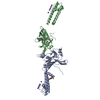
| |||||||||||||||||||||||||||||||||||||||||||||||||||
|---|---|---|---|---|---|---|---|---|---|---|---|---|---|---|---|---|---|---|---|---|---|---|---|---|---|---|---|---|---|---|---|---|---|---|---|---|---|---|---|---|---|---|---|---|---|---|---|---|---|---|---|---|
| 1 | 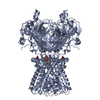
| |||||||||||||||||||||||||||||||||||||||||||||||||||
| 2 | 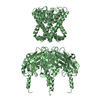
| |||||||||||||||||||||||||||||||||||||||||||||||||||
| Unit cell |
| |||||||||||||||||||||||||||||||||||||||||||||||||||
| Components on special symmetry positions |
| |||||||||||||||||||||||||||||||||||||||||||||||||||
| Details | The biological tetrameric assembly of the chain A molecule is generated by the operations: (y, 1-x, z), (1-x, 1-y, z) and (1-y, x, z). The biological tetrameric assembly of the chain B molecule is generated by the operations: (1-y, -1+x, z), (2-x, -y, z) and (1+y, 1-x, z). |
- Components
Components
| #1: Protein | Mass: 36176.582 Da / Num. of mol.: 2 Fragment: KIR3.1 (residues 3-44, 125-318), KIRBAC1.3 TRANSMEMBRANE domain (residues 45-124) Mutation: M127A Source method: isolated from a genetically manipulated source Source: (gene. exp.)   Paraburkholderia xenovorans (bacteria) Paraburkholderia xenovorans (bacteria)Genus: Burkholderia / Plasmid: pET28b(+) / Strain: LB400 / Species (production host): Escherichia coli / Production host:  #2: Sugar | ChemComp-BNG / | #3: Chemical | ChemComp-K / #4: Water | ChemComp-HOH / | |
|---|
-Experimental details
-Experiment
| Experiment | Method:  X-RAY DIFFRACTION / Number of used crystals: 1 X-RAY DIFFRACTION / Number of used crystals: 1 |
|---|
- Sample preparation
Sample preparation
| Crystal | Density Matthews: 3.1 Å3/Da / Density % sol: 60.3 % |
|---|---|
| Crystal grow | Temperature: 293 K / Method: vapor diffusion, sitting drop / pH: 6.2 Details: 10-15% (w/v) PEG 4000, 0.05M sodium citrate, 0.2M potassium phosphate, 0.08M bis-tris, 0.12M KCl, 0.003M dithiothreitol, 0.02M tris (2-carboxyethyl) phosphine hydrochloride, 0.0026M 1,2- ...Details: 10-15% (w/v) PEG 4000, 0.05M sodium citrate, 0.2M potassium phosphate, 0.08M bis-tris, 0.12M KCl, 0.003M dithiothreitol, 0.02M tris (2-carboxyethyl) phosphine hydrochloride, 0.0026M 1,2-dihexanoyl phosphatidylinositol 4,5-biphosphate, 0.016M nonylglucoside , pH 6.2, VAPOR DIFFUSION, SITTING DROP, temperature 293.0K |
-Data collection
| Diffraction | Mean temperature: 100 K |
|---|---|
| Diffraction source | Source:  SYNCHROTRON / Site: SYNCHROTRON / Site:  NSLS NSLS  / Beamline: X29A / Wavelength: 1.1 Å / Beamline: X29A / Wavelength: 1.1 Å |
| Detector | Type: ADSC QUANTUM 315 / Detector: CCD / Date: Aug 2, 2006 |
| Radiation | Monochromator: DOUBLE CRYSTALS (Silicon) / Protocol: SINGLE WAVELENGTH / Monochromatic (M) / Laue (L): M / Scattering type: x-ray |
| Radiation wavelength | Wavelength: 1.1 Å / Relative weight: 1 |
| Reflection | Resolution: 2.2→100 Å / Num. all: 43991 / Num. obs: 43991 / % possible obs: 97.9 % / Observed criterion σ(F): 0 / Observed criterion σ(I): -3 / Redundancy: 3.7 % / Biso Wilson estimate: 46.1 Å2 / Rsym value: 0.054 / Net I/σ(I): 17 |
| Reflection shell | Resolution: 2.2→2.28 Å / Redundancy: 3.7 % / Mean I/σ(I) obs: 3.9 / Num. unique all: 4450 / Rsym value: 0.309 / % possible all: 99.7 |
- Processing
Processing
| Software |
| ||||||||||||||||||||||||||||
|---|---|---|---|---|---|---|---|---|---|---|---|---|---|---|---|---|---|---|---|---|---|---|---|---|---|---|---|---|---|
| Refinement | Method to determine structure:  MOLECULAR REPLACEMENT MOLECULAR REPLACEMENTStarting model: PDB ENTRIES 1N9P, 1P7B Resolution: 2.2→29.5 Å Isotropic thermal model: Anisotropic model for the reflection data and restrained individual isotoropic temperature factors for the coordinates Cross valid method: THROUGHOUT / σ(F): 0 / Stereochemistry target values: Engh & Huber Details: During the refinement, only the anisotropic components of the correction were applied to the data, the isotropic component was not applied to the coordinates. The bulk solvent correction was ...Details: During the refinement, only the anisotropic components of the correction were applied to the data, the isotropic component was not applied to the coordinates. The bulk solvent correction was applied between 5-2.2 A. Potassium ions are located using another crystal soaked in a rubidium-containing solution.
| ||||||||||||||||||||||||||||
| Displacement parameters | Biso mean: 51.229 Å2
| ||||||||||||||||||||||||||||
| Refine analyze |
| ||||||||||||||||||||||||||||
| Refinement step | Cycle: LAST / Resolution: 2.2→29.5 Å
| ||||||||||||||||||||||||||||
| Refine LS restraints |
| ||||||||||||||||||||||||||||
| LS refinement shell | Resolution: 2.2→2.37 Å / Rfactor Rfree error: 0.015
|
 Movie
Movie Controller
Controller



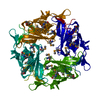
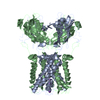
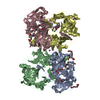
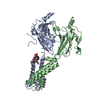
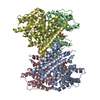
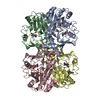

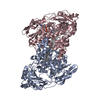
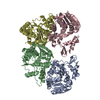
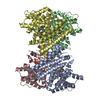
 PDBj
PDBj




